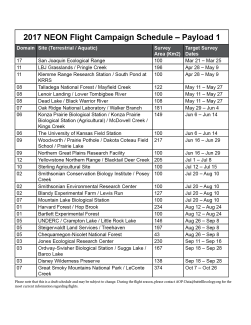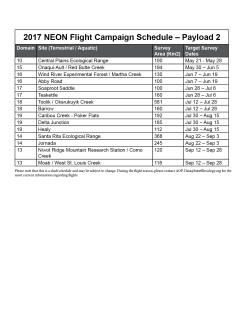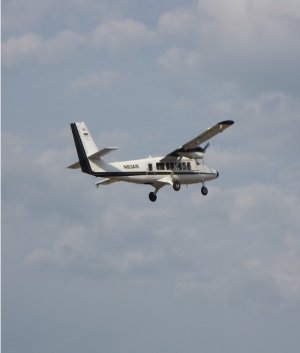2017 NEON AOP flight campaign schedule now available
February 24, 2017
We are excited to announce the 2017 flight campaign schedule for NEON’s Airborne Observation Platform. The campaign will run from March to November, covering eighteen NEON domains with forty-three terrestrial sites and twenty-four aquatic sites using two payloads (scroll down for maps, tables and related KMZ files). The remote sensing instruments – consisting of an imaging spectrometer, a waveform light detection and ranging (LIDAR) instrument and a high-resolution digital camera – are mounted into a DeHavilland DHC-6 Twin Otter aircraft flying at a nominal altitude of 1000 m above ground level (AGL) at a speed of 100 knots. The flight parameters enable meter-scale spectroscopy, decimeter-scale photography, and ~4 points-per-meter discreet and waveform lidar measurements at a sufficient signal-to-noise ratio to retrieve vegetation vertical structure and biogeochemical properties from measured reflectance spectra.
At each terrestrial site a minimum of 100 km2 will be surveyed over an area encompassing the NEON tower airsheds and distributed long-term sampling plots, representative vegetation types, and watershed boundaries for both the terrestrial and aquatics sites. To minimize signal uncertainty due to plant phenology and to ensure spatial and temporal consistency in data products across multiple years, all terrestrial sites are scheduled to be flown during mean peak greenness, defined as the range of dates where MODIS NDVI is within 90% of the site maximum. To minimize atmospheric effects, data acquisition occurs at less than 10% cloud cover.
Planning your research in coordination with AOP flights
If you would like to plan research activities on the ground to coincide with AOP surveys of certain areas, please email us to join our mailing list. The NEON AOP flight operations team will email daily reports on the status of flights over each site which will be more accurate than the schedule posted in this article. Although the NEON AOP flight operations team will attempt adherence to the the published schedule, weather and logistical constraints may result in modifications to this plan.
Requests for NEON to fly additional areas
Due to the intensive nature of the NEON Flight Campaigns, we are unable to include additional flight areas to the existing plan. However, in 2018 we anticipate an additional payload will be available to support Principal Investigator (PI)-led science flights. You can learn more about how to make requests through our Assignable Assets Program.
What data are available now?
NEON already provides freely available airborne data by request from our previous flight surveys. Explore what’s available on our Airborne Data page. There are also many other complementary data products that are downloadable from the [[nid:5909]].
Related maps, tables and KMZs


